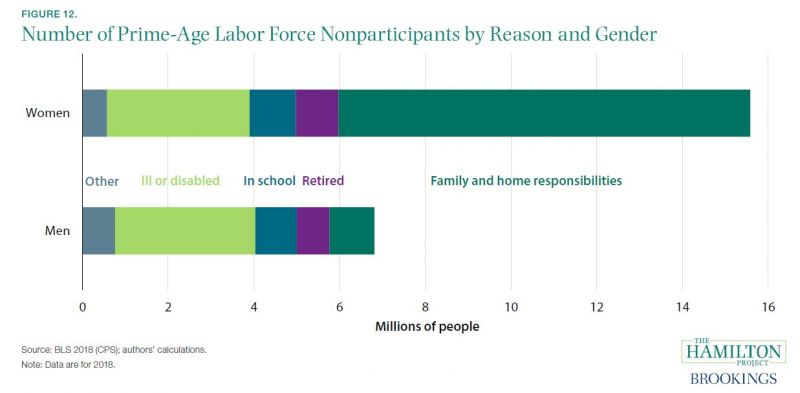The Evolution of Labor Force Participation
Over the last two decades the U.S. labor force participation rate has fallen. While the relatively strong job market since 2014 has led to rising participation for some groups, the overall participation rate remains well below its peak even after adjusting for aging. These changes in the United States have not been mirrored around the world. In 1990, the U.S. had participation rates near the OECD average for prime-age (25–54) men, and were well above the average for prime-age women. By 2016, the U.S. male participation rate was well below the OECD average, and U.S. women were only slightly above the OECD average.
There are sizable gaps in prime-age participation across groups in the United States: women participate at a lower rate than men (13.7 percentage points), Black men participate at a lower rate than White men (7.4 percentage points). Adults 25 and older without high school degrees participate at lower rates (and work for much less pay) than adults with at least a college degree (27.6 percentage points). Those with family caregiving responsibilities, those facing health and disability challenges, and those with a history of incarceration are all far less likely to work than other adults. Some of these factors are evident in the figure below, which shows the stated reasons for nonparticipation among those aged 25 to 54.
 For more than a decade, The Hamilton Project has offered evidence-based policy proposals on a variety of topics that often have important implications for labor force participation. We discuss these proposals as they relate to the goal of increasing participation, with a special focus on the barriers to increased participation, including weak aggregate demand, low demand for non-college-educated workers, geographic gaps in participation, caregiving responsibilities, health and disability, and criminal justice.
For more than a decade, The Hamilton Project has offered evidence-based policy proposals on a variety of topics that often have important implications for labor force participation. We discuss these proposals as they relate to the goal of increasing participation, with a special focus on the barriers to increased participation, including weak aggregate demand, low demand for non-college-educated workers, geographic gaps in participation, caregiving responsibilities, health and disability, and criminal justice.
Impediments to Labor Force Participation and Potential Policy Solutions
Weak Aggregate Demand
Recessions, economic slowdowns, or more broadly shortfalls in aggregate demand—the total spending by individuals, firms, and governments—depress labor force participation, with longer-run impacts if workers become permanently discouraged, either leaving the labor force or remaining on a less-rewarding career track.
- Automatic stabilizers—defined as fiscal policies that automatically inject money into the economy during a downturn and remove it during a boom—can help minimize the damage caused by recessions. (To learn more, read the book Recession Ready by The Hamilton Project (THP) and the Washington Center for Equitable Growth, and also a THP proposal by Jared Bernstein.)
Weak Demand for Non-College-Educated Workers
Falling labor demand for non-college-educated workers has weakened the returns to work and lowered labor force participation for many workers.
- After-tax policies supplement market wages through the tax and transfer system. Expanding after-tax policies such as the Earned Income Tax Credit (EITC) would raise the return to work for low-wage workers and could increase participation. (To learn more, read a THP proposal by Hilary Hoynes, Jesse Rothstein, and Krista Ruffini on the EITC.)
- Before-tax policies raise the wages that employers are willing to pay either by increasing skills or by making markets more competitive and dynamic. Policies that promote worker training, increased access to education, and more dynamic markets could all increase participation. (To learn more, read a THP proposal by Harry Holzer.)
Geographic Gaps in Participation
Labor force participation varies dramatically across the country. Places with low participation rates may suffer from weakness in both labor demand and labor supply.
- Place-based policies, such as geographically targeted job subsidies, closer links between struggling places and research universities, or intergovernmental grants to places with the most need, can help people in struggling places. (To learn more, read the THP book Place-Based Policies for Shared Economic Growth including a proposal by David Neumark.)
- Policies that encourage mobility can help people move to places with greater labor market opportunity.
Family Caregiving
Caregiving, both for children and aging relatives, is often extremely expensive. For mothers of young children in particular this expense is enough to deter labor force participation.
- Policies that make it easier to balance employment and caregiving, such as paid parental leave, intermittent leave for caregiving, or affordable child care, could help caregivers to stay in the labor force. (To learn more, read a THP proposal by Elizabeth Cascio.) Policies that address the penalty faced by secondary earners within families can help as well (see a THP proposal by Melissa Kearney and Lesley Turner.)
Health, Disability, and Drug and Alcohol Abuse
Illness and disability account for nearly 30 percent of prime-age nonparticipation. Improving health and making disability less of a barrier to employment would increase participation.
- Disability insurance reform can incentivize employers to accommodate workers with disabilities and make it easier for workers to participate in the labor force. (To learn more, read a THP proposal by David Autor and Mark Duggan.)
Incarceration and Collateral Consequences
Incarceration and interactions with the criminal justice system come with long-term labor market consequences including forgone human capital accumulation, hiring restrictions, higher likelihood of recidivism, and discrimination.
Reducing the punitiveness of the U.S. criminal justice system—including by eliminating some collateral consequences of conviction—would increase LFPR. (To learn more, read a THP proposal by Anne Piehl.)



